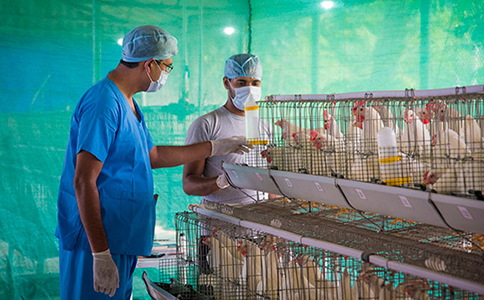


Livestock sector is an emerging segment of the expanding and diversifying agricultural sector having enormous potential to contribute to the Indian economy. Indian farmers generally maintain a mixed farming system - a combination of crop and livestock - where the output of one enterprise becomes the input of the other thus maximizing the resource utilization to the fullest extent. As a result, Indian livestock industry is growing at a Compound annual growth rate of 13%.
The demand for livestock-derived foods is growing in low- and middle-income countries, managing the associated transitions in the production of these food products emerges as a key policy debate. Strategic investments in the global livestock business offers opportunities for sustainable expansion of this sector where improved resource utilization efficiency, secured social equity, and strengthened resilience of the underlying production systems have been identified as the key elements. However, the dynamics of livestock production and consumption of LDF differ across developing regions which leads to significant heterogeneity in the opportunities and poses threats associated with expansion of the sector.
The enormous heterogeneity in the opportunities notwithstanding, livestock sector has an enormous growth potential which, if tapped correctly with the possible threat points plugged in, can serve as the source of sustenance as well as profit.
 Project protocols are developed by leading veterinarians and nutritionists of South East Asia.
Project protocols are developed by leading veterinarians and nutritionists of South East Asia.
 The research is conducted by experienced technical professionals.
The research is conducted by experienced technical professionals.
 The experimental stations are equipped with state-of-the-art facilities, integrated with laboratory services.
The experimental stations are equipped with state-of-the-art facilities, integrated with laboratory services.
 Wide range of research services are offered at an affordable cost to enable all segments of the livestock industry to take the advantage of Agrivet Research Services.
Wide range of research services are offered at an affordable cost to enable all segments of the livestock industry to take the advantage of Agrivet Research Services.
Located in Kolkata, India, connected globally, Agrivet is a “one-of-its-kind” Contract Research Organisation catering to the livestock industry. At Agrivet Research Center, basic and applied research is carried out for benefiting the livestock fraternity across the globe.
ACPL research facilities are systematically divided into different departments and categories. This is ideal for research planning and best representation of current animal farming in tropical countries.
The experimental station consists of two research locations both of which are just 45 minutes’ drive from the NSCBI Airport and approximately an hour driving distance from the Kolkata city centre.
The facility is equipped with state-of-the-art facilities, integrated with laboratory services. The laboratories are located at the research farm and head office.
Research facility is divided into different divisions like Poultry, Aqua and Dairy research.
 Poultry Research
Poultry Research
 Performance trait (live weight, feed intake, feed conversion ratio, livability and productivity index) measurement.
Performance trait (live weight, feed intake, feed conversion ratio, livability and productivity index) measurement.
 Cost of production and overall economics of production calculation.
Cost of production and overall economics of production calculation.
 Uniformity Analysis.
Uniformity Analysis.
 Evaluation of different nutrient specifications on broiler performance.
Evaluation of different nutrient specifications on broiler performance.
 Zootechnical and commercial viability studies on alternative ingredients.
Zootechnical and commercial viability studies on alternative ingredients.
 Comparative evaluation of premix components.
Comparative evaluation of premix components.
 Dose optimization of specific additives under different conditions of management and environment.
Dose optimization of specific additives under different conditions of management and environment.
 Challenging the birds with specially developed models involving microorganisms ,heat, overcrowding and toxins.
Challenging the birds with specially developed models involving microorganisms ,heat, overcrowding and toxins.
 Microorganisms | Heat | Overcrowding | Toxins
Microorganisms | Heat | Overcrowding | Toxins
 Ileal digestibility of nutrients (energy, nitrogen, amino acids, fat)by total tract apparent digestibility method or by apparent ileal digestibility method using Celite, chromic oxide or titanium dioxide as the marker.
Ileal digestibility of nutrients (energy, nitrogen, amino acids, fat)by total tract apparent digestibility method or by apparent ileal digestibility method using Celite, chromic oxide or titanium dioxide as the marker.
 Dressing yield
Dressing yield  Yields of commercial cuts (breast, legs, thighs and giblets)
Yields of commercial cuts (breast, legs, thighs and giblets)  Lean meat and abdominal fat yields
Lean meat and abdominal fat yields Meat shear strength
Meat shear strength Drip loss | Water holding capacity | Meat pH
Drip loss | Water holding capacity | Meat pH Shrinkage loss following cooking
Shrinkage loss following cooking Organoleptic parameters according to Hedonic scale
Organoleptic parameters according to Hedonic scale  White stripping scoring of breast muscles with photographs
White stripping scoring of breast muscles with photographs  Regular blood biochemistry (serum/plasma)
Regular blood biochemistry (serum/plasma) Enzyme activity measurements (serum/plasma)
Enzyme activity measurements (serum/plasma) Mineral Estimation (blood/serum/plasma)
Mineral Estimation (blood/serum/plasma) Blood pH
Blood pH Differential leucocyte counts
Differential leucocyte counts Haemoglobin and haematocrit
Haemoglobin and haematocrit Enumeration of coccidia oocysts in
Enumeration of coccidia oocysts in  Enumeration of bacteria for Total count, Total anaerobes and Total coliforms
Enumeration of bacteria for Total count, Total anaerobes and Total coliforms Enumeration of specific bacteria (Salmonella, Lactobacillus, Escherichia coli and Clostridium perfringens)
Enumeration of specific bacteria (Salmonella, Lactobacillus, Escherichia coli and Clostridium perfringens)  Study of litter materials for Coccidia oocysts and Bacterial species (Salmonella, Lactobacillus, Escherichia coli and Clostridium perfringens)
Study of litter materials for Coccidia oocysts and Bacterial species (Salmonella, Lactobacillus, Escherichia coli and Clostridium perfringens) Villus height, crypt depth and VH to CD ratio of
Villus height, crypt depth and VH to CD ratio of Histology of trachea and lungs, Kidney, Liver
Histology of trachea and lungs, Kidney, Liver Histopathological examinations and interpretations of small intestinal lesions in enteric challenge studies for Necrotic enteritis | Bacterial enteritis | Cocci challenge
Histopathological examinations and interpretations of small intestinal lesions in enteric challenge studies for Necrotic enteritis | Bacterial enteritis | Cocci challenge Cell-mediated immunity
Cell-mediated immunity  Humoral immunity
Humoral immunity Respiratory tract health monitoring through tracheal scoring
Respiratory tract health monitoring through tracheal scoring Intestinal lesion scoring
Intestinal lesion scoring Foot pad lesion scoring
Foot pad lesion scoring  Macroscopic scoring of tibia for dyschondroplasia lesions
Macroscopic scoring of tibia for dyschondroplasia lesions Bone mineralization study is accomplished by measuring
Bone mineralization study is accomplished by measuring Estimation of Hepatic Lipidosis by ether extract of Liver triturate
Estimation of Hepatic Lipidosis by ether extract of Liver triturate Gait score measurements
Gait score measurements Pathogenicity study of enteric bacteria through qPCR technique
Pathogenicity study of enteric bacteria through qPCR technique Measurement of Ileal digestibility of nutrients through digestibility markers
Measurement of Ileal digestibility of nutrients through digestibility markers Analysis of litter materials for
Analysis of litter materials for  Morphometry study of Small Intestine (weight and length of gut, including gross visual lesions)
Morphometry study of Small Intestine (weight and length of gut, including gross visual lesions)  Necropsy of dead birds with detailed report
Necropsy of dead birds with detailed report  Pelleting Parameters of different stages of experimental feed
Pelleting Parameters of different stages of experimental feed Nutrient retention study through protein and fat accretion in whole carcass
Nutrient retention study through protein and fat accretion in whole carcass Proximate analysis of Raw Material / Feed (Through NIR)
Proximate analysis of Raw Material / Feed (Through NIR) Thermal Imaging of birds during each feeding stage with interpretation
Thermal Imaging of birds during each feeding stage with interpretation  Body weight | Egg production | Egg weight and Egg mass | Feed consumption, FCR | Mortality
Body weight | Egg production | Egg weight and Egg mass | Feed consumption, FCR | Mortality  Measurements of Haugh Units
Measurements of Haugh Units Yolk pigmentation (YCF 4 to 15)
Yolk pigmentation (YCF 4 to 15)  Egg shell thickness and breaking strength
Egg shell thickness and breaking strength Particle size distribution study
Particle size distribution study Mixing uniformity study
Mixing uniformity study Pellet Durability Index
Pellet Durability Index Pellet Hardness
Pellet Hardness Pelleting efficiency test
Pelleting efficiency test Post pelleting recovery of enzyme
Post pelleting recovery of enzyme post pelleting recovery of DSM
post pelleting recovery of DSM Pellet Disintegration Test
Pellet Disintegration Test Microbiology
Microbiology Biotechnology and Biochemistry
Biotechnology and Biochemistry Pathology and Parasitology
Pathology and Parasitology NIRS and Wet Chemistry
NIRS and Wet Chemistry Feed Testing Lab
Feed Testing Lab Research is conducted on IMC / Shrimp / Other Fin Fishes
Research is conducted on IMC / Shrimp / Other Fin Fishes Aqua research facility is located at DGN
Aqua research facility is located at DGN Independent aerated recirculation tanks are installed
Independent aerated recirculation tanks are installed  Tanks are circular with 500 lit water capacity
Tanks are circular with 500 lit water capacity 31 individual tanks allow the flexibility to conduct elaborate research
31 individual tanks allow the flexibility to conduct elaborate research Following parameters can be generated from Production trials
Following parameters can be generated from Production trials
 Coming soon
Coming soon© Agrivet Research & Advisory . All Rights Reserved | Design & Developed by DITS